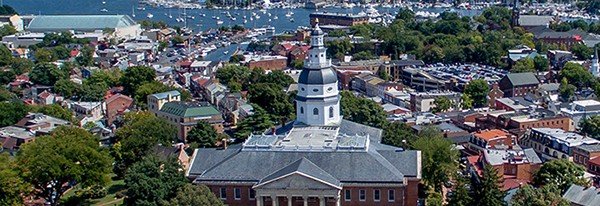The Historic Marker Program spans fifty years and more than 300 properties. These octagonal markers have become an icon of the Annapolis Historic District. While highlighting preserved buildings, these markers also tell residents and visitors more about the property on which they are displayed. A color-coded system is used to signify different architectural periods, while a brass inset displays the building name, date of construction, and architectural style, which can be found below.
How do I get a Historic Marker for my home?
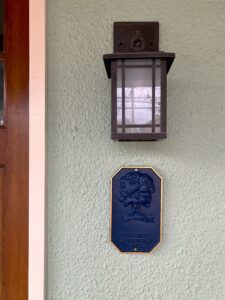
We encourage all eligible property owners to join our program! For more information, click here.
NEW! Historic Annapolis introduces our Little Marker Program to celebrate the architecture and preservation of buildings outside the Annapolis National Historic Landmark District.
If you interested, or not sure if you are eligible for a traditional or little marker, please email Rachel Robinson, VP of Preservation, at rachel.robinson@annapolis.org.
Guide to Architectural Styles
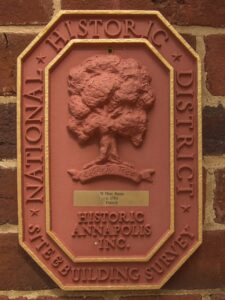 Red: Georgian Architecture (1715-1800)
Red: Georgian Architecture (1715-1800)
The Georgian style is among the most long-lived styles of American architecture and dominated the English colonies for most of the 18th century. In 1700, the style emerged in the British colonies when an expanding and increasingly prosperous population began to seek more fashionable buildings.
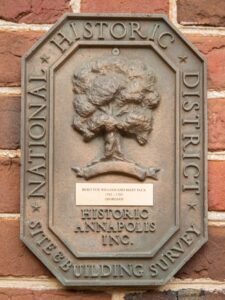 Bronze: Georgian Buildings of National Importance (1730-1800)
Bronze: Georgian Buildings of National Importance (1730-1800)
Bronze markers indicate buildings of the Georgian style that are important on a national level for their architecture and role in the founding of America. Annapolis has a higher proportion of Georgian buildings than any other American city. The State House, William Paca House, James Brice House and Ridout Row are just a few of the excellent examples of these buildings with national importance.
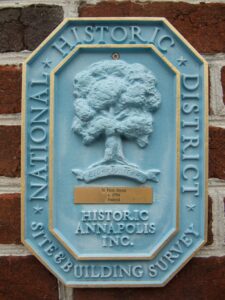 Blue: Federal Architecture (1784-1840)
Blue: Federal Architecture (1784-1840)
This style is often characterized as having a lightness and delicacy in comparison to its Georgian relatives. The exteriors have few elaborations other than the fanlight and accentuated front door. However, elaborations sometimes occur in the form of roof-line balustrades, the use of a Palladian-style window over the main entrance, and the use of dormers, as well as the use of keystone lintels above windows with prominent sills.
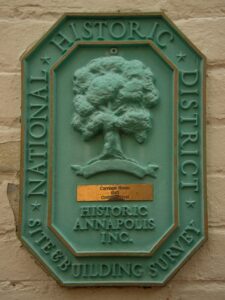 Green: Greek Revival Architecture (1820-1860)
Green: Greek Revival Architecture (1820-1860)
During and after the War of 1812, American affection for British influence diminished, which brought an increasing interest in classical building to the new nation, including Annapolis. In Annapolis, the style is evident on many domestic structures: large square or elongated windows, restrained ornament, and pedimented or simple entablatured entrances.
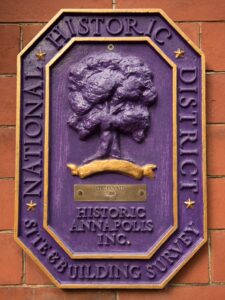 Purple: Victorian Era Architecture (1869-1901)
Purple: Victorian Era Architecture (1869-1901)
This marker designates a wide range of architectural styles that share such elaborate massing and detail: French Second Empire, Italianate, Queen Anne, Gothic Revival, and Romanesque. Exterior decoration in the brickwork, multiple-hued color scheme, towers, elaborate brackets and consoles, arched and bay windows, as well as verandas exemplify some defining features of the architectural styles of the Victorian era.
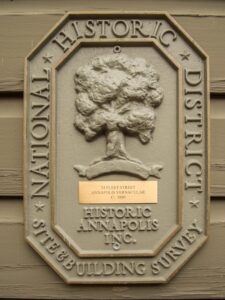 Gray: 19th-20th Century Annapolis Vernacular Architecture (1837-1921)
Gray: 19th-20th Century Annapolis Vernacular Architecture (1837-1921)
This style employs simplified classical, Federal, and Italianate motifs. They are sometimes row or paired houses and reflect local culture and building materials. Vernacular Annapolis structures, such as those on Conduit and Market Streets, are ubiquitous throughout the city and contribute significantly to the streetscape and character of the town.
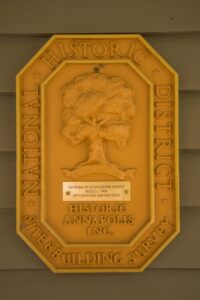 Yellow: 20th Century Distinctive Architecture (1901-1938)
Yellow: 20th Century Distinctive Architecture (1901-1938)
20th century distinctive architecture represents a variety of styles ranging from the Beaux Arts, Colonial and Tudor Revival, and Craftsman styles, those mentioned being more commonly found in Annapolis. The American Foursquare is an example of this style and common in Maryland during this time period, and can be found on Duke of Gloucester Street.


